on VW Atlas, car ownership questioned & an EV bike from Cleveland
VW ups the Atlas. . .EU provides EV incentives (for chargers). . .Mazda CX-30 and Lexus RZ 450e reviewed. . .who wants to own a vehicle asked. . .building bikes in Cleveland. . .a clever folding EV scooter. . .the Rimac Nevera rips it at Goodwood. . .
VW Advances the Atlas
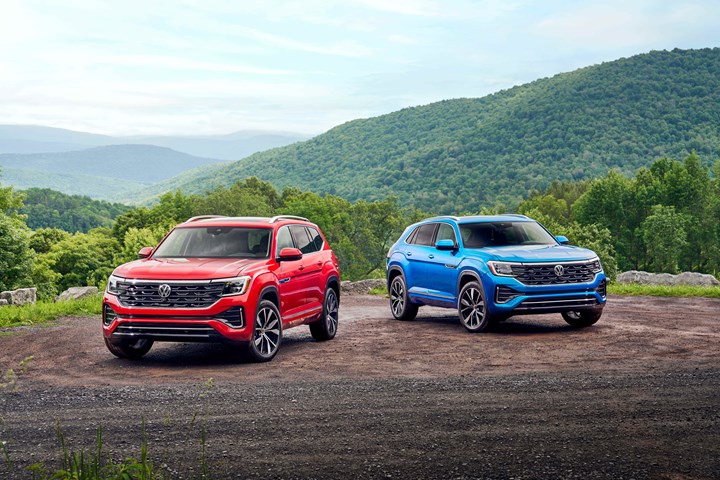
The 2024 VW Atlas (left) and Atlas Cross Sport (right). Styling changes inside and out. (Image: Volkswagen of America)
It does bring Goldilocks to mind.*
Ten years ago Volkswagen of America was a car company.
As in 91% of the vehicles it sold in 2013 were cars.
It’s not that it didn’t have SUVs.
But the Tiguan back then was too small.
The Touareg was too expensive.
So they decided to build something else. Something that would resonate well in the U.S. which then, as now, was SUV-centric in buying habits.
In December 2016 the Atlas went into production at the company’s assembly plant in Chattanooga, Tennessee.
And it proved to be “just right.”
A vehicle available with seven places that could meet the needs of families (or people who just like room).
Then the idea came to make things a bit more sporty.
In March 2020 customers could get the Atlas Cross Sport, too.
It Worked
As of the end of the first half of 2023 Volkswagen of America is arguably an SUV company: 85% of its sales are SUVs. (Calendar year 2022 ended at 83% SUVs, so clearly things are growing.)
A big part of that are the two versions of the Atlas.
In the first half the two accounted for sales of 40,628 units, or a third of all of the SUVs (123,028) VW delivered during the first half.
Updated
For model year 2024 Atlas and Atlas Sport have had a mid-cycle update.
Yes, there is the obligatory change to the front fascia. In this case there are LED headlamps with adaptive front lighting; daytime running lights that wrap around the headlights; a light bar that runs just below the hood opening and connects the DRLs; and an illuminated VW badge (these last two on most trims).
And there is a change around back, too, with an illuminated light bar stretching from side to side and lighted logo. This necessitated a new stamping tool, so it is a different hatch than the one on the ’23. In addition to which, there is a longer spoiler above the back light and small airfoils integrated on the vehicle to help improve aerodynamics. (The coefficient of drag of both body styles is 0.33.)
Inside Change
“The big, big, big difference,” says VW’s Serban Boldea, “is the interior. We changed a lot more than what you would expect in an update of a vehicle. Even the door panels for the rear doors.”
(The front door panel are changed, too.)
One big visible change in the interior is driven by something that is otherwise invisible. Boldea says the Atlas uses a new electrical architecture. One consequence is that the previous “mechanical shifter in the center console that is literally a device with cables that go out to the transmission has been replaced by an electronic shifter.” Shift-by-wire. He points out that the previous electrical architecture is incapable of handling the shifter interface of this type.
(The eight-speed Aisin transmission is the same, just the means by which it gets inputs from the driver is different.)
In addition to which, there are other enhancements that the electrical architecture facilitates, like the VW IQ.DRIVE advanced driver assistance system that utilizes front and rear radar, a front camera, and ultrasonic sensors to provide functions from semi-automated driving assistance to lane-keeping assist to adaptive cruise control with stop-and-go to. . . . Again, something that requires a more robust E/E setup.
Transformation Under the Hood
Another major change is in a place that probably most people won’t see, as well: Under the hood.
(Seriously: when is the last time you popped the hood on your vehicle?)
The outgoing Atlas is available with either a 2.0-liter in-line four cylinder engine that produces 235 hp and 258 lb-ft of torque or a 3.6-liter V6 that provides 276 hp and 266 lb-ft of torque.
One of the things Boldea says they wanted for the 2024 Atlas models was across-the-board 5,000-pound towing capability.
In the previous generation the 2.0-liter four was rated for 2,000 pounds while the V6 could accommodate 5,000 pounds.
But they were also looking for across-the-board efficiency.
They wanted to offer the Atlas with just one powertrain, not two.
And they concluded that going with a four would be better than a six.
Boldea says they looked at the two four-cylinder engine families that VW has in the U.S., the EA211 and EA888.
While the EA211 has efficiency on its side, Boldea says that they concluded that the 158 hp and 184 lb-ft of torque as found in the engine’s application in the Jetta wouldn’t get them to the towing rating they wanted.
So it was to the 2.0-liter EA888 engine family. An EA888 is used in the 2023 Golf R performance hatch.
The EA888 for the 5,000-pound towing was tuned so that it produces 269 hp and 273 lb-ft of torque. This four, unlike the previous, can do the task.
At the same time, comparing base AWD models of the outgoing and the ’24, the former is rated at 20 mpg city, 24 highway and 22 combined, while the new Atlas is at 19 city, 26 highway and 22 combined.
But as only the V6 in the previous model was rated for the 5,000-pound towing, its AWD version miles per gallon are 16 city, 22 highway and 18 combined. A non-trivial delta between those numbers and those achieved by the EA888 in the ’24 Atlas.
While the 2.0 liter gives up a bit on the horsepower side to the 3.6-liter, it has better torque, which helps when pulling that Airstream.
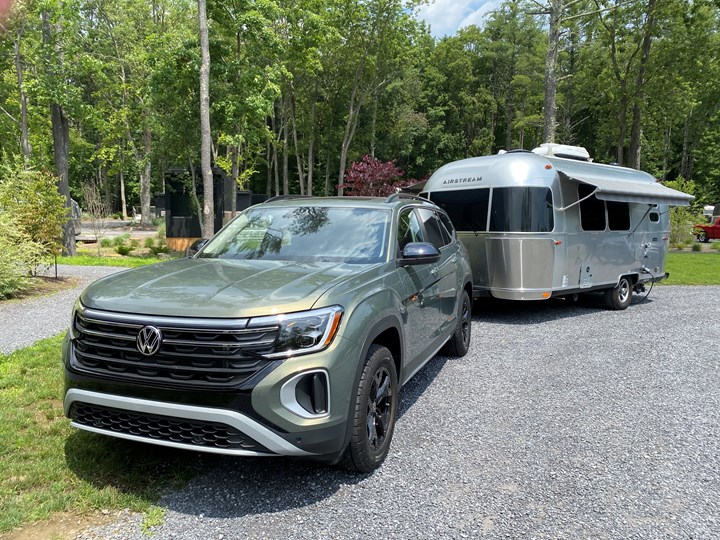
==
*While the three bears might seem to be a stretch analogy, remember: the Atlas is the kind of vehicle that you can take the whole family in, so fairy tales may be part of the journey.
///
In the EU: Buy a Home Charger, Get an Incentive
Anyone who has even the slightest interest in buying an electric vehicle in the U.S. knows of the potential $7,500 federal tax credit.
The U.S. isn’t the only Western country that is using the power of the purse to persuade people to go electric.
Of the 27 European Union (EU) member states, 20 offer incentives for purchasing electric car. The others provide various tax methods for EVs.
This, according to the European Automobile Manufacturer’s Association (ACEA).
What’s more notable is how some countries are incentivizing home infrastructure.
In Austria, consumers can get:
- €600 for an intelligent charging cable
- €600 for a wall box
If someone in Demark gets a company vehicle that is an EV, then the value of the charging setup at the employee’s residence isn’t taxed.
In Italy, the government will provide domestic users with 80% of the purchase and installation price of a home charger up to €1,500.
Sweden provides a 50% tax deduction—up to SEK 15,000 (which is about $1,381 U.S.)—for the installation of a home charger.
As in the U.S., charging infrastructure—or the lack thereof—is cited as an inhibitor to the growth in sales of what the ACEA calls “electrically chargeable vehicles” (ECVs).
However, in 2022 21.6% of the new cars registered in the EU were ECVs, so they’re certainly not doing badly there.
///2023 Mazda CX-30 Turbo Premium Plus
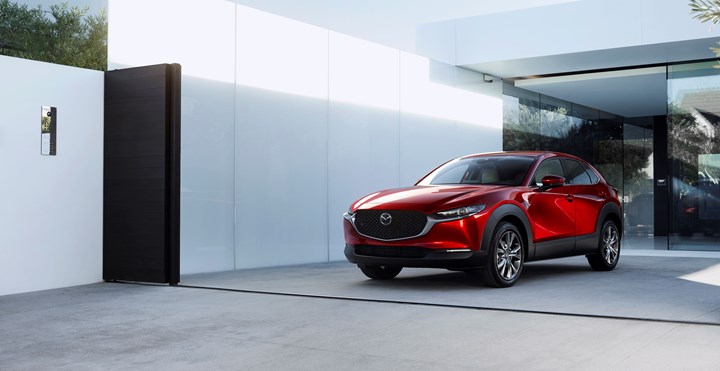
Mazda takes a premium approach. (Image: Mazda)
The Mazda CX-30 subcompact crossover features a SKYACTIV-G 2.5-liter turbocharged engine that produces 227 hp if you pump regular and 250 hp if you put premium in the 12.7-gallon tank. It is mated to a SKYACTIV-DRIVE six-speed automatic with sport and manual-shift mode. The vehicle has all-wheel drive, the i-Activ system, which monitors weight distribution as the vehicle is in motion and automatically sending power to the wheels where needed. That is focused on the paved portions of one’s journey; there is Off-Road Traction Assist, too, although one would suspect that were one to be off road in the CX-30 it probably has more to do with overcoming the G-Vectoring Control Plus system (this monitors the driver’s steering inputs so that it can adjust the engine power as needed to make turning feel more natural).
[Whew!]
With all of the SKYACTIV and i-Activ and the like you might get the sense that this is a somewhat complicated crossover to drive, something that requires an extensive driver’s manual that you need to pour over before getting behind the wheel.
That’s not the case. Simply push the start button, put it in gear, and drive.
Premium Focus
But all that nomenclature goes to a point in Mazda’s past when performance was the focus of the brand’s proposition. But now the focus has shifted to “premium.” Which is just as well because odds are there are more people who are interested in nice than fast. And the SKYACTIV-G turbo in the CX-30 notwithstanding, I didn’t find the vehicle to be neck-snapping peppy, though I did find myself admiring the layout and the material orchestration in the interiors.
And for being a small CUV (173 inches long; 70.7 inches wide, 62.2 inches high), I found the fuel economy to be somewhat shrug-worthy at best: 22/30/25 mpg city/highway/combined.
According to the Federal Highway Administration, most commuters-->75%--drive alone. Which is probably a good thing for CX-30 owners because the rear seat doesn’t lend itself to a comfortable commute for full-size humans and, because when that rear seat is folded, there is 45.2 cubic feet of cargo capacity, which is beneficial, so cargo can trump additional passenger.
Where to Start
The CX-30 is the entry to the Mazda lineup. It has a starting MSRP of $22,950. However, the one that I had the opportunity to drive starts at $35,400, so perhaps I was taken with the interior just because of that. But it does bring with it amenities like leather on the seats and steering wheel (which happens to be heated), a Bose 12-speaker system, nicely brushed metallic trim, and other features. So it is premium content for the money.
A word about the paint on the vehicle. This is one area where Mazda really seems to overachieve. Its metallic and mica finishes, yes with a bit of an upcharge, are really quite rich and robust, the sort of thing that provides the appropriate touch to the comparatively sinuous sheet metal.
Let’s face it: Among the things important about a vehicle are (1) how it looks outside and (2) how it looks inside.
Mazda checks both of those boxes.
///
Artisanal Motorcycle Manufacturing—in Cleveland
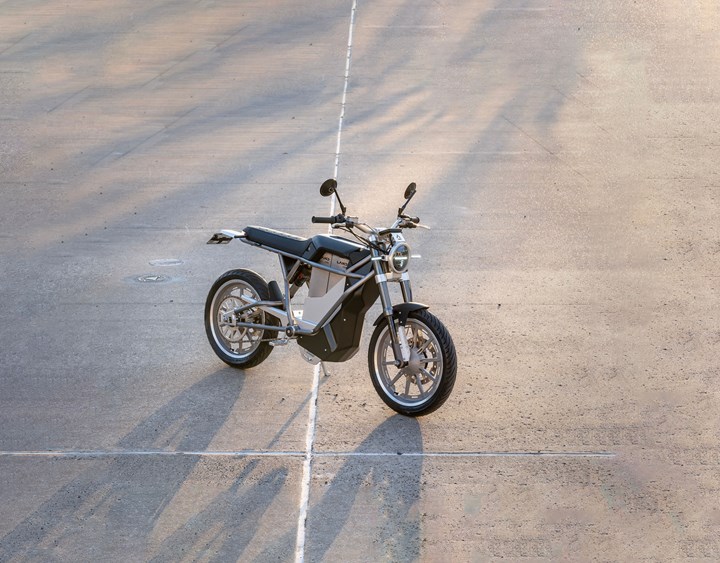
The District, an electric motorcycle, being built in Cleveland by LAND. (Image: LAND)
- “Vertically integrated” from the IoT stack to design, engineering and manufacturing.
- “Accessible, hand-crafted, minimalist.”
- Cleveland, Ohio (a.k.a., “the Land”).
Those are characteristics LAND Energy, a start-up that’s producing e-bikes in a newly renovated 30,000-square foot facility in northeast Ohio.
According to Evan Painter, head of design at LAND, the company’s flagship bike, The District, is based on a cold-drawn DOM stainless-steel frame that is TIG welded in house.
The current production staff is 10 people. Consequently, the production is on the order of 30 or fewer bikes per month. Painter points out, however, that they are looking to greatly increase that now that they’ve got the renovated facility.
The bikes use INR 21700 cells—lithium nickel manganese cobalt oxide. The batteries are packaged in swappable packs assembled in the factory. There are three sizes: 1.8-, 3.6-and 5.5-kWh (all net figures). These provide ranges of up 40 40, 80 or 120 miles. The CORE batteries are internet enabled for over-the-air updates and configured so that they can be used for non-mobile applications (e.g., power storage; charging things that aren’t e-bikes).
Although the whole thing is small-batch for the moment, it speaks to innovation and imagination.
///
Why Buy?

Zipcar-sponsored survey finds that lots of people are becoming less interested in vehicle ownership. (Image: Zipcar)
First a grain of salt: the survey, conducted by Wakefield Research, was sponsored by Zipcar, the car-sharing service owned by car-rental company Avis Budget Group.
Second, a bold statement predicated on the findings:
“The traditional American idea of owning a car – receiving the gift of new keys at sixteen, as a graduation surprise, or to drive around a city – is dead.
“Car owners are feeling the stress of car ownership and are increasingly adopting affordable transportation options easily accessible at their fingertips. Why waste time and money on a car that sits unused and parked most of the time?”--Angelo Adams, Head of Zipcar
Third, some of the findings:
- 35% of American adults are “somewhat likely” to give up personal vehicle ownership by the end of the decade
- 18% are “very” or “extremely” likely to do so
- 51% of Millennials (born 1981-1996) and 45% of Gen Z (1997-2102) are ready to go without private wheels
- 21% of Boomers (1946-1964) and 28% of Gen X (1965-1980) are seriously considering giving up the keys
Comment: Anecdotal information about young people not being as keen on driving as their elders is common. Note how the older generations are less interested in not owning a vehicle while the younger ones are.
Zipcar has approximately one-million members, so there is some serious substance there.
Even if the results of the survey are off by a considerable percentage, it still doesn’t bode well for OEMs and suppliers.
///
Fold the Scooter with a Push of a Button

The Series 1 in folded form. (Image: LAVOIE)
McLaren Applied—yes, until a couple years ago part of McLaren Group of F1 and sports car fame—produces a variety of advanced tech products for vehicles, like 800-V silicon carbide inverters, accelerometers, and ATLAS (Advanced Telemetry Linked Acquisition System) software.
The 30 years it has spent being involved at the highest levels of motorsports has oriented the company toward developments that overachieve.
McLaren Applied has created a micromobility company, LAVOIE, that has announced the Series 1. . .an electric scooter.
What makes this scooter—with design input from Ian Callum and his team at CALLUM Design (evidently British firms have a thing for all-caps)—different is a patent-pending folding capability.
It’s called “Flowfold.”
Press a button and the stem collapses and the wheel moves above the deck.
This design apparently does several things for the electric scooter (two battery sizes are available 468 Wh, which is said to be good for 25 miles @ 12 mph, and 702 Wh, which gives a 38-mile range at the same speed—although either version allows a top speed of 25 mph):
- Compact size when folded
- A longer, wider deck
- Higher stem angle for “automotive-like” steering
- Enhanced shock and vibration absorption
If You Have to Ask. . .
The base Series 1 starts at just under $2,500.
///
2023 Lexus RZ 450e Luxury
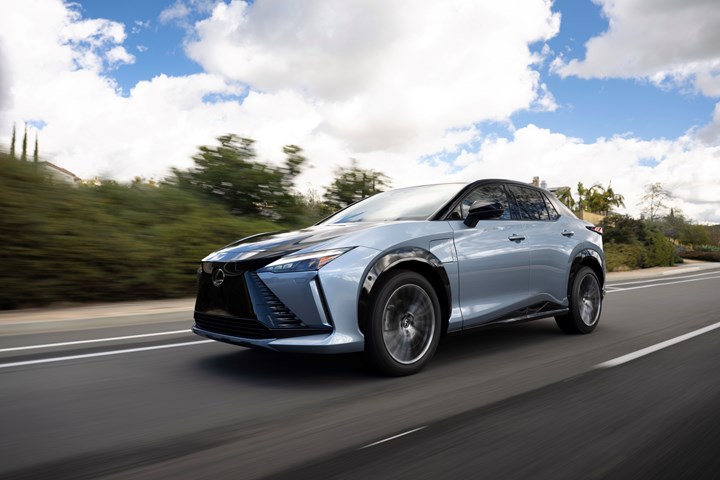
The first Lexus EV, the RX 450e. Magnificent styling. Meh range. (Image: Lexus)
Maybe it has something to do with the fact that when driving the Lexus RZ 450e Asteroid City was doing Wes Anderson-well in the theaters because when I learned the 71.4-kWh lithium-ion battery pack was developed for the vehicle by Prime Planet Energy & Solutions I had to check whether it is real.
It is.
It is a joint-venture company. Panasonic (49%) and Toyota (51%).
Established on April 1, 2020.
At the introduction of the company Hiroaki Koda, representative director and president, said:
“With advanced fusion of Panasonic’s top-level safety, superior quality and reliability, Toyota’s leading electric vehicle electrification, and advanced battery development, and manufacturing as the mutual strength, we aim to be a company that can always deliver new value widely to all customers with the aim of a prosperous future.”
When it comes to batteries—and not only is Prime Planet in the prismatic li-ion production business, but intends to develop, manufacture and sell automotive solid-state batteries and “next-generation”—I suspect this outfit is going to do rather well.
==
The RZ is the first Lexus global purpose-built electric vehicle.
Lexus plans to offer 100% battery electric vehicles on a global basis by 2035.
That’s the sort of thing that many luxury marques are talking.
One suspects that if the demand is there, Lexus will do it.
If the demand wanes, they will adjust accordingly.
There is, after all, the Toyota Production System is at use at the Motomachi Plant in Toyota City, where the RZ is built.
(The other companies that don’t have a robust production system that allows comparatively quick changes may find themselves with a lot of underused capacity.)
==
The RZ is based on the e-TNGA platform that is used for the Toyota bZ4X EV, too.
The TNGA platform initially began production existence in 2019 for the last-generation Prius.
The platform has been modified and enhanced since. Like for fully electric vehicles, beyond hybrids.
However, given that:
- Toyota has announced it will be making a new EV due in 2026 that will use gigacastings
- It has established a BEV Factory division
- It has installed gigacasting equipment in Motomachi
Odds are e-TNGA, advanced assembly techniques like laser screw welding notwithstanding, is going to have a limited existence.
==
The RZ looks great.
While there was lots (and lots) of criticism of the Lexus design language when the spindle grille appeared, (1) the language has gotten more sophisticated and (2) the environment has changed such that Lexus vehicles simply seem avant-garde, not bizarre.
In some ways the interior seems classic Lexus, with comfortable seats and well-appointed features (e.g., Ultrasuede trim; 14-inch touchscreen with an anti-glare coating). In other ways it is different: there is no glovebox, with that space being taken by an available radiant heater, which is a more efficient way to warm the passenger quickly than blowing air. (The shift-by-wire system provides space under the rotary shifter on the center console to accommodate what used to be put in the glovebox.)
==
What is not so great is the range.
There are two permanent magnet synchronous motors, one in the front, one in the back, 201 hp and 107 hp, respectively, for a total system output of 308 hp.
There is a 71.4-kWh lithium-ion battery.
The RZ range for vehicles with 18-inch tires is 220 miles.
With 20-inch tires: 196 miles.
Presumably Prime Planet Energy & Solutions has some work to do.
///
(Un)Stately Speed

"Taking on the narrow hillclimb at Goodwood, with its tight corners and off-camber sections, is actually one of the scariest places to drive a car quickly.”-- Miroslav Zrnčević, Chief Test and Development Driver, Bugatti Rimac (Image: Rimac)
This past weekend at the Goodwood Festival of Speed—a car event held on the estate of the Duke of Richmond in the south of England—the Rimac Nevera, an electric vehicle, set a production car record in the legendary 1.16-mile hill climb.
Miroslav Zrnčević, Chief Test and Development Driver, Bugatti Rimac, performed the feat in 49.23 seconds.
That “production car” is a bit of a stretch—or whatever the opposite of stretch might be: there will be 150 Nevera’s built at the Rimac complex outside Zagreb, Croatia.
Last month three of the cars were delivered to customers in the U.S.
What’s theoretically interesting (because let’s face it: none of us is likely to ever drive one) is that there are four electric motors in the car, one per wheel: two 295 hp/207-lb-ft units in the front; two 644-hp/664-lb-ft in the rear.
Rimac engineers had to develop electronic control units to manage the four powertrains and are employing an NVIDIA Pegasus system that provides information to the powertrains 100 times per second.
That’s fast, too.
\\\
RELATED CONTENT
-
How to Build a Military Vehicle from a Pickup Truck
A real piece of military gear. A real pickup that you can get at a Chevy dealership. A really remarkable story.
-
GAC, CATL Partner on Two Battery Ventures
Two new battery ventures are being formed in China by domestic carmaker Guangzhou Automobile Group Ltd. and battery giant Contemporary Amperex Technology Ltd.
-
on lots of electric trucks. . .Grand Highlander. . .atomically analyzing additive. . .geometric designs. . .Dodge Hornet. . .
EVs slowdown. . .Ram’s latest in electricity. . .the Grand Highlander is. . .additive at the atomic level. . .advanced—and retro—designs. . .the Dodge Hornet. . .Rimac in reverse. . .


.jpg;width=70;height=70;mode=crop)






